Polymarket attracts crypto-native users and international traders, while Kalshi is born for Wall Street.
Written by: Thejaswini M A
Translated by: Luffy, Foresight News
For months, you have been watching the Federal Reserve meetings, knowing they are about to adjust interest rates. Economic data is loudly signaling, inflation numbers are corroborating it, and even subtle changes in Powell's wording are hinting at the arrival of this moment.
But how do you turn this judgment into a trade?
Of course, you could buy bonds, expecting them to rise when interest rates fall; or short the dollar, praying the correlation remains unchanged; or heavily invest in interest-sensitive tech stocks, hoping the market interprets the news as you expect.
But what if… you could directly trade the Federal Reserve's decisions? Instead of playing these indirect "derivative games," you could directly bet on "Will the Fed lower interest rates at the next meeting?" and earn $1 for each contract if you guess correctly?
Let’s talk about sports betting. You could buy New Balance stock, hoping Coco Gauff winning the Australian Open boosts athletic apparel sales; you could short Nike because their sponsored athlete got eliminated early; or you could invest in DraftKings, betting that rising tennis viewership will drive up betting volume. But what if… you could directly bet on whether Gauff can win the Australian Open? Put down $100, guess correctly, and get $200, without having to analyze corporate earnings reports.
You could buy TKO Group stock, hoping WrestleMania attracts record viewers; you could short a competitor's entertainment company stock; or bet on merchandise sales skyrocketing. But what if… you could directly trade whether Roman Reigns can retain his championship title? Put your money directly on the storyline outcome, skipping all media company analyses.
This is exactly what Kalshi allows you to do.
Kalshi is the first regulated prediction market by the U.S. Commodity Futures Trading Commission (CFTC), where you can directly trade the outcomes of real-world events—not stocks affected by events, not currencies that may fluctuate due to news, but the events themselves.
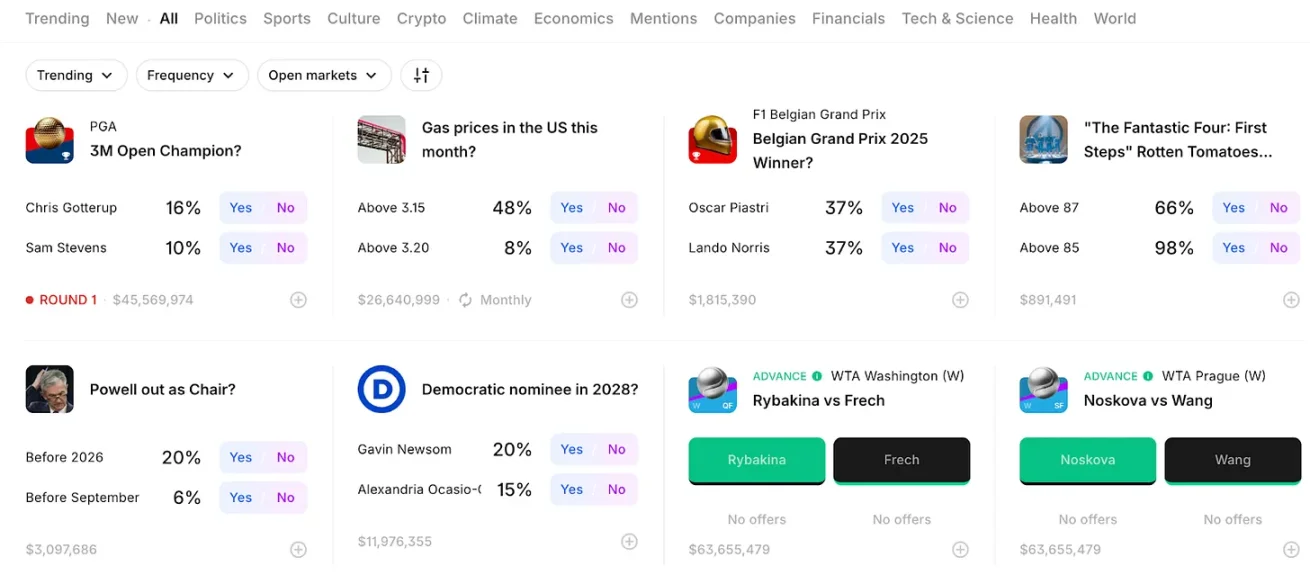
Make Your Predictions Valuable
Federal Reserve decisions, election results, Supreme Court rulings, whether Bitcoin can rise to $150,000, whether inflation will exceed 4%, whether your favorite team can win the championship… as long as you can form an opinion and the outcome has an objective measurement standard, there may be a corresponding market on Kalshi.
Polymarket pioneered the concept of modern prediction markets, handling billions of dollars in trading volume during the U.S. elections, proving the immense demand for such markets. Kalshi has just raised $185 million at a $2 billion valuation, with large trading firms like Susquehanna providing liquidity, and Robinhood integrating Kalshi markets directly into its platform, allowing millions of retail traders to participate. Elon Musk's Grok AI has even embedded its trading interface.
This is a regulated, institutional-grade "trading reality" infrastructure. Building on Polymarket's global layout, Kalshi has brought prediction markets into the regulated U.S. financial system.
Think about what this means: for the first time, you can directly monetize the advantage of predicting real-world events without enduring the friction of traditional financial markets—no complex derivatives, no counterparty risk, and no worrying about whether your hedging tools will actually work when the event occurs.
If you think the next non-farm payroll report will be surprising, there’s a corresponding market; if you believe Trump will win the 2028 election, you can trade related contracts now; if you are certain that AI companies will dominate the next decade, you can bet on specific milestones and regulatory outcomes that will determine their fate.
This platform turns every piece of non-public information, every analytical advantage, and every evidence-based prediction into a potential profit opportunity. Unlike traditional markets that arbitrage information advantages through complex strategies, prediction markets directly reward knowledge.
How Kalshi Works
Understanding how Kalshi operates is crucial because the mechanics of event contracts differ from any financial instruments you have traded before. Let me walk you through it step by step with a real example.
Step 1: Account Setup and Funding
Create an account at kalshi.com and complete the necessary identity verification (KYC). Since Kalshi is regulated by the CFTC, you will need to provide standard documents such as identification and proof of address.
For funding, Kalshi offers various options with different limits and processing speeds: bank transfers are free but take 1-2 business days; debit cards are instant but incur a 2% fee with a daily limit of $2,500; cryptocurrency users can deposit USDC with a daily limit of $500,000, credited within 30 minutes; wire transfers are suitable for large amounts but have minimum requirements.
Step 2: Understanding Market Pricing
Enter any market to view the current pricing structure. For example, in the "Will Bitcoin reach $150,000 before 2026?" market: currently, the "Yes" contract is priced at $0.44, and the "No" contract at $0.59, meaning the market believes there is a 44% chance Bitcoin will reach $150,000 before 2026.
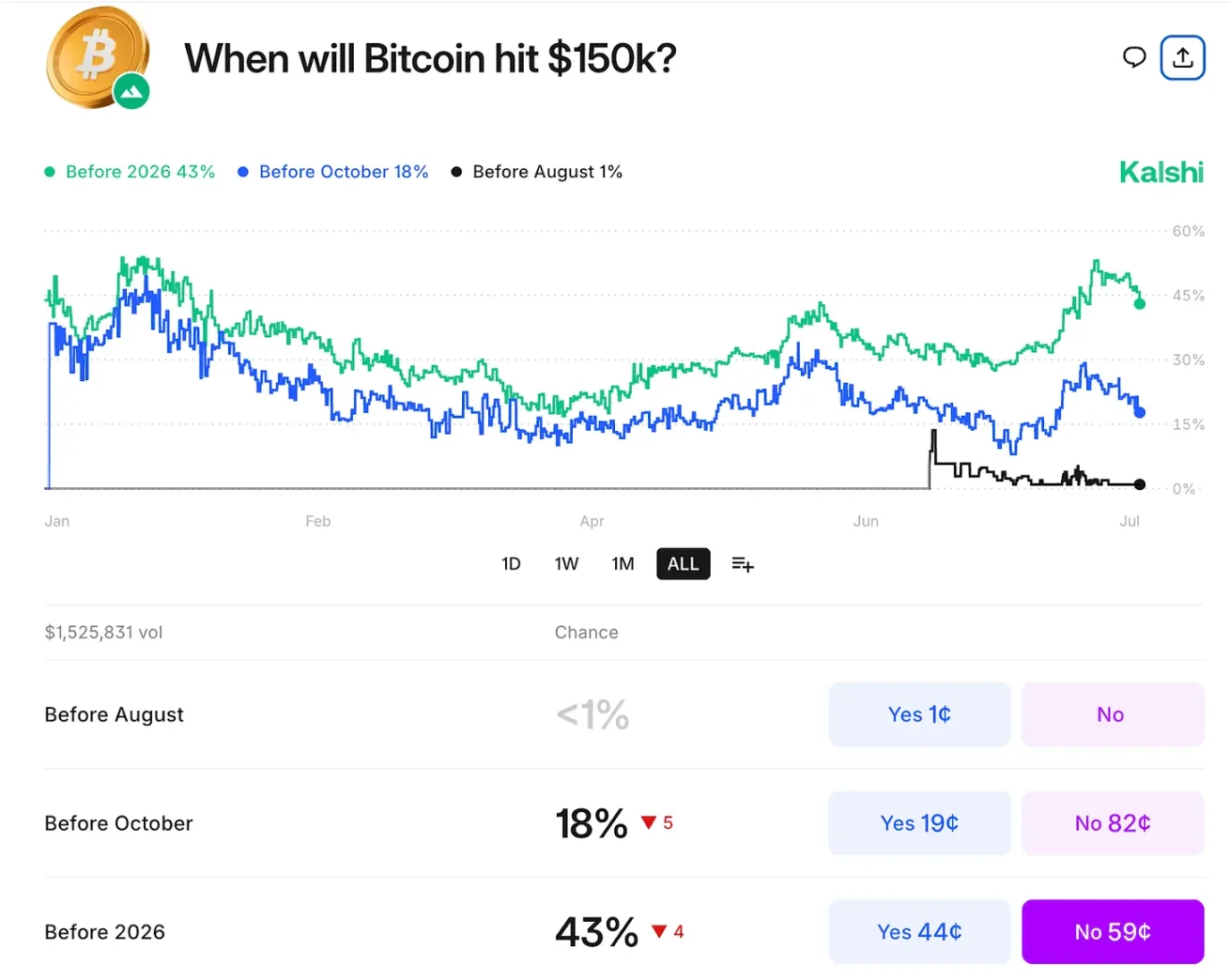
The interface clearly displays your potential earnings: if you buy a "Yes" contract at $0.44, and Bitcoin does reach $150,000, you will receive $1 per contract, earning $0.56 per contract; if it does not reach that price, the contract expires worthless.
The trading process is as follows: suppose you believe Bitcoin will reach $150,000 and want to buy 100 "Yes" contracts at $0.44 each, totaling $44. If Bitcoin meets the target before 2026, each contract pays out $1, giving you a total of $100 and a profit of $56; if it does not meet the target, the contract expires, and you lose $44.
Step 3: Placing Orders
Choose to buy "Yes" or "No" contracts, enter the amount (minimum $1), and the platform will automatically calculate how many contracts you can buy and your maximum profit.
Using the Bitcoin example: buying a $1 "Yes" contract at $0.44 allows you to purchase approximately 2.27 contracts. If you guess correctly, you will receive $2.27, earning $1.27. The calculation process is transparent before confirming the trade.
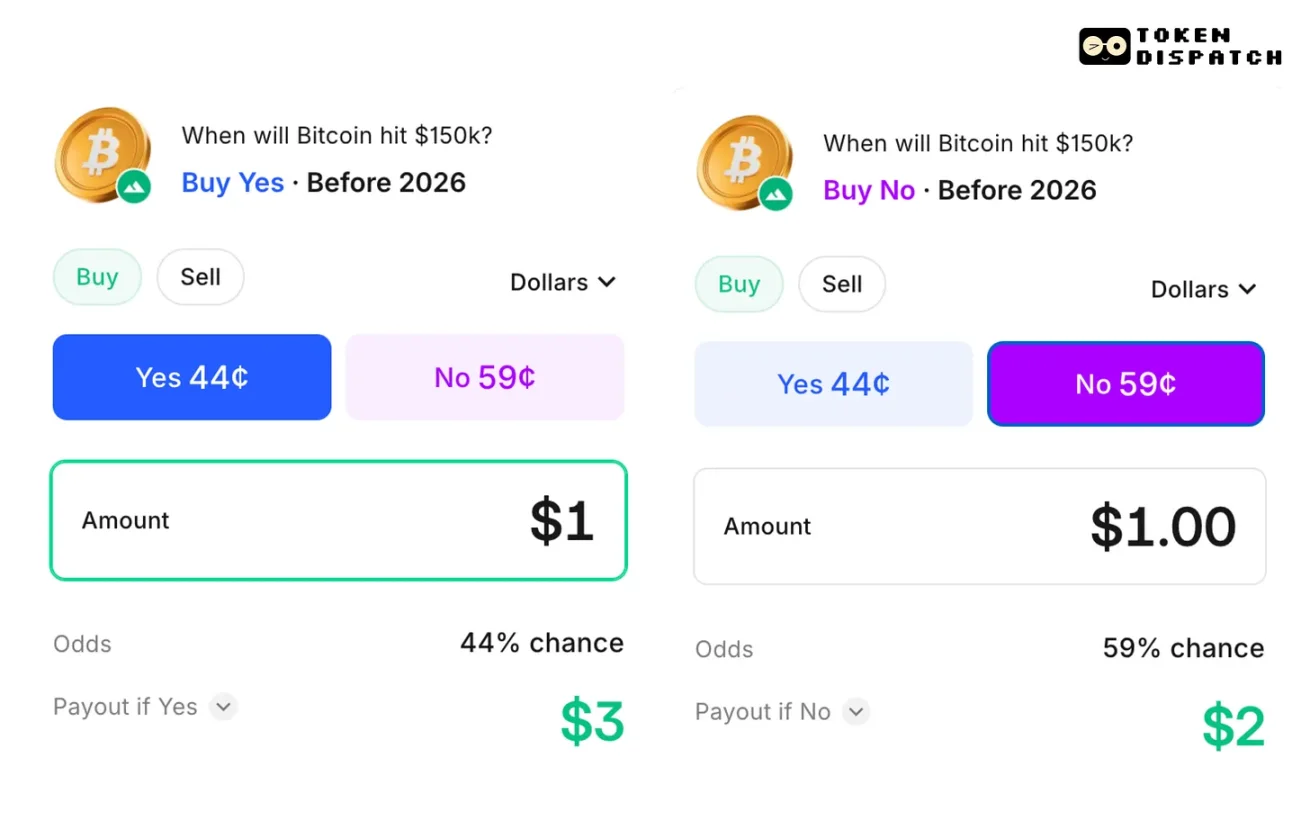
The brilliance of this model lies in its simplicity: your maximum loss is the purchase cost, and your maximum profit is $1 per contract minus the purchase price, with no margin calls, no complex Greek letters, and no overnight financing costs.
Step 4: Multiple Time Frames
Many markets offer contracts for the same event across different time frames. The Bitcoin $150,000 market has options like "by August" (current probability 1%), "by October" (18% probability), and "by 2026" (43% probability).
Each time frame's trading is independent. If you believe Bitcoin will only reach $150,000 next year, you can buy the "Yes" contract expiring in 2026 while simultaneously selling the "Yes" contract expiring in August.
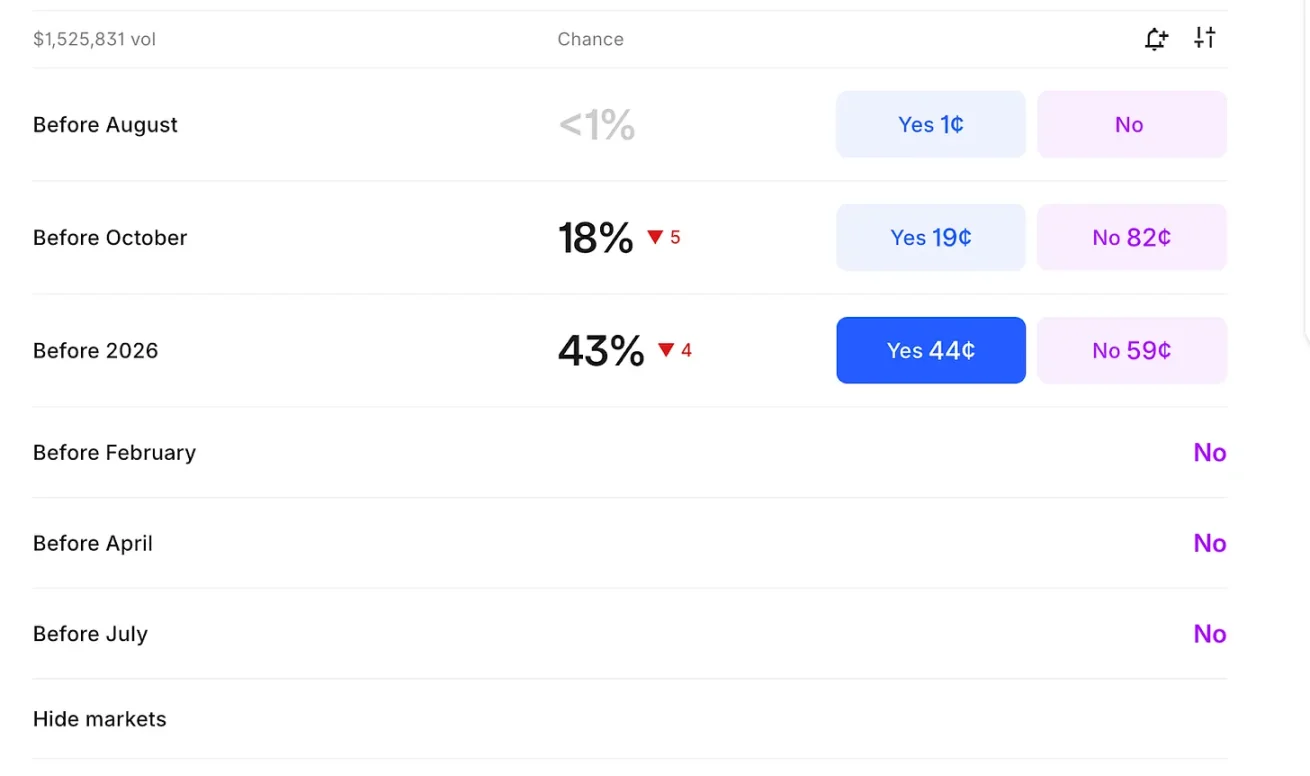
Step 5: Monitoring and Closing Positions
You do not have to hold until expiration; contract prices fluctuate in real-time with news and market sentiment. The platform displays real-time price charts, allowing you to track probability changes.
If significant news breaks that affects your position, you can sell immediately. For example, if you bought the Bitcoin "Yes" contract at $0.44 and positive news drives the price up to $0.60, you can sell immediately, earning $0.16 per contract without waiting for the final outcome.
Closing positions is smooth: you can place a market order (trading immediately at the current price) or a limit order (waiting for a target price), and potential profits and losses will be displayed before confirming the trade. Settlement is automatically completed through pre-set data sources—no disputes, no interpretation, just the data.
Position limits prevent any single trader from manipulating the market. Most retail traders can trade a maximum of $25,000 per contract, while institutional traders enjoy higher limits. Fees are charged at 0.7%-3.5% of the contract value, depending on market probability, with contracts close to 50/50 odds having higher fees than extremely unlikely contracts.
Market Classification and Discovery
Kalshi categorizes markets into several categories: politics, sports, economics, cryptocurrency, climate, etc. Popular sectors highlight markets with high activity or recent price volatility.
The platform also features a "Views" section where users discuss market analysis and share trading logic. This community aspect helps you discover new markets and understand different perspectives on event probabilities.
For active traders, Kalshi offers an API interface that supports algorithmic trading and data analysis: you can access historical price data, automate orders, and integrate Kalshi markets into broader trading strategies.
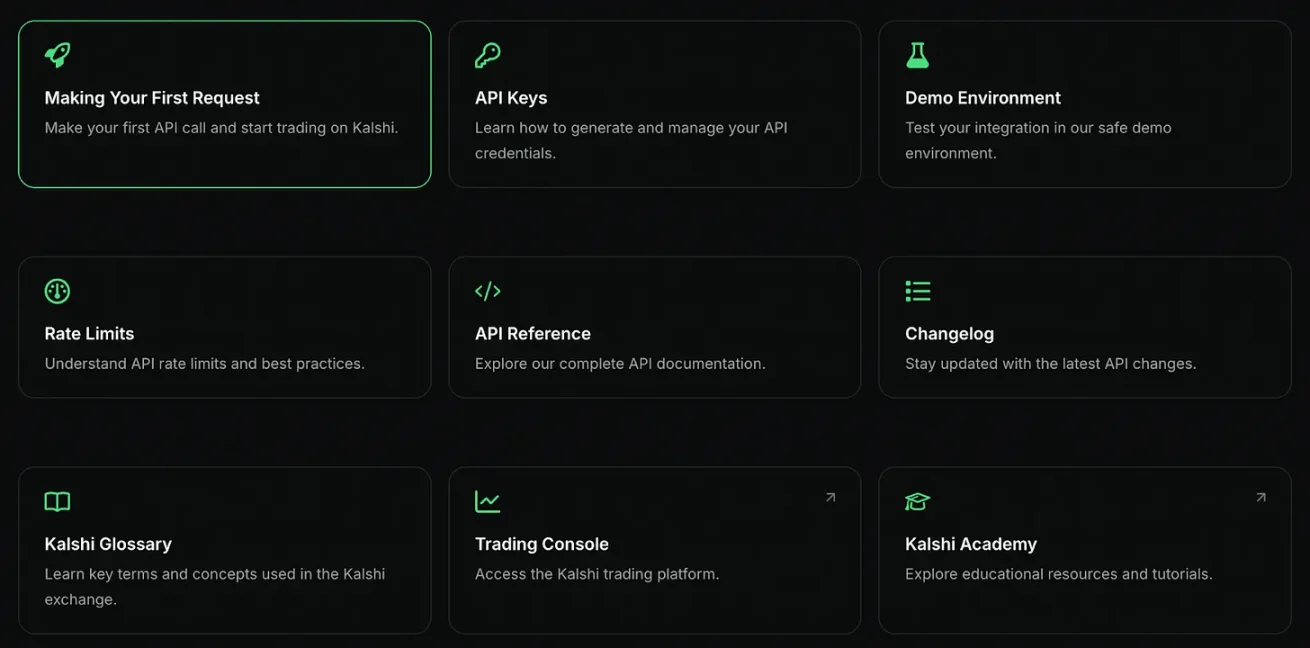
The platform also provides detailed transaction volume and open interest data for each contract, helping you assess liquidity before making large trades.
Its brilliance lies in its simplicity: no complex derivatives, no leverage, counterparty risk is limited to the exchange itself, only a pure information market, with transparent and regulated settlements.
Investment managers use Kalshi to hedge specific event risks that traditional tools cannot efficiently cover: a clean energy fund worried about regulatory changes can directly trade policy outcome contracts to hedge; a portfolio heavily invested in tech stocks can hedge against antitrust action risks by trading related legal markets.
If you hold $1 million in assets, a specific policy change could reduce its value by 20%. Spending $50,000 to buy a hedge contract with a 25% probability means that if the event occurs, you can receive $200,000, perfectly offsetting the portfolio loss.
Traders with expertise can directly monetize their knowledge: political insiders trade election markets, economic analysts trade Federal Reserve decision contracts, and industry experts trade regulatory outcome markets. Unlike the stock market—where information advantages are quickly arbitraged through complex derivative strategies—event markets allow excellent predictions to be directly converted into profits. Your advantage in predicting FDA approvals or Supreme Court rulings can immediately turn into trading gains.
Grok Integration
Recent collaboration with xAI has shown us the future of information trading.
The integration of Grok within the Kalshi interface provides on-chain data, historical odds, and real-time analysis of breaking news. Before placing an order, users can query Grok for background information on events, probability assessments, and related data trends.
This creates a feedback loop: AI helps traders make better predictions, and the outcomes of prediction markets can train the AI system's real-world forecasting capabilities. Grok is tested in real-time probability assessments, while traders gain AI-enhanced information analysis.
Its impact extends beyond individual trading decisions: as AI systems become better at processing vast amounts of information and recognizing probability patterns, prediction markets will become more efficient. This means narrower spreads, more accurate price discovery, and more practical hedging applications.
Comparison of Kalshi and Polymarket
The prediction market space now has two complementary leaders: Polymarket pioneered the prediction market industry with crypto-native innovations, while Kalshi was born for Wall Street.
Core Differences
Kalshi is fully regulated by the CFTC, with funds held in federally insured accounts, and disputes resolved through clear processes, operating in a manner consistent with traditional finance: funding via bank transfers, trading in USD, and withdrawing to checking accounts.
Polymarket settles in USDC and resolves disputes through decentralized oracles, proving the model's viability globally, and has recently obtained appropriate licenses in the U.S. to expand into regulated markets.
Audience Differences
Institutional funds flow to Kalshi because regulation brings certainty: large market makers like Susquehanna provide liquidity, with over $1 billion in monthly trading volume demonstrating mainstream market preference for compliant platforms.
Polymarket's innovations and global reach attract crypto-native users and international traders who value decentralization and permissionless access. Its early success validated the value of the entire prediction market category.
Conclusion
For U.S. users who value regulatory protection and integration with traditional finance, Kalshi has a clear advantage; for global users who adapt to crypto infrastructure and recognize Polymarket's innovations, the latter holds unique value. Both platforms drive the prediction market into the mainstream from different angles, and their mutual growth reflects the demand for this new asset class from both institutions and retail investors.
What This Means for Your Strategy
Whether you are managing a portfolio, building trading strategies, or looking to understand financial trends, the rise of Kalshi is worth noting.
For portfolio managers: event contracts provide precise hedging tools, covering risks that traditional tools struggle to address: political risk, regulatory risk, and macro event risk can now be directly hedged without relying on imperfect correlations.
For active traders: the informational advantage of predicting real-world events can be directly monetized, providing a clear profit path for your expertise in specific areas.
For long-term investors: understanding the evolution of prediction markets helps capture the idea of "financializing all measurable uncertainties." Companies that build this type of infrastructure early may reap substantial rewards.
Regulated prediction markets are akin to DeFi in 2019: still in their infancy, but with a clear product-market fit, they have enormous growth potential as infrastructure improves and adoption rates increase.
Kalshi's $2 billion valuation and growing institutional adoption indicate that we have moved past the experimental phase, and event contracts are becoming a legitimate asset class. Traders who adapt quickly will gain a first-mover advantage in this rapidly expanding market.
Kalshi serves as the infrastructure layer for "trading reality," and as the boundaries between information and markets continue to blur, the value of this infrastructure will become increasingly prominent.
免责声明:本文章仅代表作者个人观点,不代表本平台的立场和观点。本文章仅供信息分享,不构成对任何人的任何投资建议。用户与作者之间的任何争议,与本平台无关。如网页中刊载的文章或图片涉及侵权,请提供相关的权利证明和身份证明发送邮件到support@aicoin.com,本平台相关工作人员将会进行核查。




